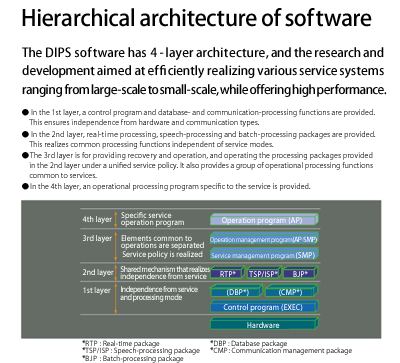The development and provisioning of the DIPS-OS series was divided into two streams, one for the time-sharing system (TSS) and the other for the real-time system (RTS), as with other commercial OSs, from the outset. However, the division into two types would limit enhancements to new requirements for OS functions that would in due course become more sophisticated as complex processing with TSS and RTS. The division would also cause problems with respect to the factors of common modifications to both streams, e.g., in the case of supporting new hardware, because duplicate investments were required in maintenance and management and to add OS functions.
For that reason, the ECL of NTT decided to migrate the two streams into a single development line of standardized OSs for DIPS by unifying the basic functions of the existing OSs between the TSS and RTS systems, while the TSS-specific and the RTS-specific functions were organized into two packages from which functions could be selected based on the service requirements. The development with the two streams unified resulted in 104-02OS.
For the basic structure of the unified OS, the following conditions had to be met in migrating the two OS lines.
- (a) Provide both TSS and RTS capabilities while maintaining consistency with existing services and applications
- (b) Allow selection from both TSS and RTS functions for each service system
As a result, as with the RTS functions, it was decided to implement the TSS functions as one software package (TSP: time-sharing package) that would run on the core OS functions. The 104-01OS for RTS was selected as the base core OS for migration.
To achieve migration of functions between two OS streams, suitable methods were selected in implementation while taking into account the differences between the functional configurations: a method of adding a function to the core OS, a method of adding basic parts of the function to the core OS and then achieving it as a TSP support function, and a method of unification by adopting the implementation of the function from the core 104-01OS.
As for communication control functions, manufacturers were standardizing these functions in the form of network architecture. Nippon Telegraph and Telephone Public Corporation (now called Nippon Telegraph and Telephone Corporation) also standardized the communication control functions as data communication network architecture (DCNA). As a result, though communication control functions had been formerly implemented as part of the OS, they were implemented independent of the OS and configured as a communication package as well as network resource virtualization.
The two streams were thus migrated and the subsequent functional expansion of DIPS-OS was to be realized as a single stream OS supporting ultra-small-scale to super-large-scale computer systems.
The major economical advantages of integrating the OS for the TSS and the OS for the RTS were as follows: (1) reduction in maintenance and management costs, (2) avoidance of duplicated investment for modification of the software in function expansion, and (3) unification of materials and training programs.
- Reference material
- The figure shows the hierarchical architecture of the DIPS software. As indicated, the DIPS software consists of 4-layer architecture, and subsequent development was also based on this architecture. The control program (EXEC) shown in the first layer in the figure represents DIPS-OS.


